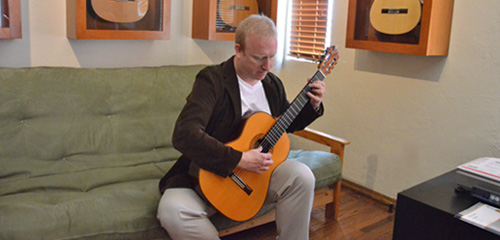Scott Morris “Phonology the Music of Erik Satie for Guitar
I recently had the opportunity to sit down with Scott Morris to talk about his latest project Phonology: The Music of Erik Satie for Guitar.
What was your inspiration for the project?
I saw that there was a hole in the guitar repertoire for early 20th century music. And a composer like Satie, who wrote such intimate music, would fit perfectly on the guitar. I wanted to help fill this need and Satie seemed like the perfect composer.
Are these arranged in order of difficulty?
No, not at all! They are arranged by categories. I started arrangements for solo guitar, guitar and voice, and finally chamber music. The arrangements in the book cover a variety of technical levels. The 5 Nocturnes for solo guitar are the most challenging and are really appropriate for professional, concert level performances. The children’s pieces could be played for a professional recital, but they’re also good for intermediate players. The cabaret songs may be performed with a singer or as solos and are moderately difficult. There’s something for everyone!
How long did the project take to complete?
I started working on the arrangements probably two years before recording any of it and actually a little before that. So I’d say it was more like three years of regular attention. It was not an overnight thing. I also arranged much more than what is in the book. I did a lot, almost twice as much, but I put what worked the best in the book. So, it could have been a much bigger book, but I wanted the quality to be there.
Which piece did you encounter the most challenging to transcribe?
Well, I tried the Sonatine Beurocratique as a solo arrangement first. A buddy of mine had looked at this piece before and warned me about trying it as a solo. He said the bass line was far too active to make it work for one guitar. I spent almost a year on that, just to prove him wrong. One day, I realized I should just split it in to two parts, and that gave me an excuse to call Andrew York. So it all worked out at the end.
So how long did you and Andy rehearse?
Andy and I rehearsed at his house just one time for maybe an hour and a half, and then we had lunch for about two hours. The next time I saw him, we were sitting in front of recording studio microphones. So it went pretty fast. I think we were able to get a little more practice in while they were checking the levels. So there was very little rehearsal, and an incredibly hard piece. I figured I would play guitar one since I had arranged the piece. It was a choice I would get punished for. They also handed us guitars we had never played before for the session. I was playing a short scale 1971 Friederich with incredibly high action. So it’s this tiny little guitar with huge action, and I’m trying to play this crazy stuff on it. Andy was pretty comfortable on a 56’ Bouchet which was beautiful.
How was it working with Andrew York?
He’s this luminary in the guitar world, but when you talk to him he’ll put you at such ease that you’ll totally forget his resume. Whatever nerves you have, after a couple of notes you are just playing with your buddy.
Click to Order “Phonology, The Music of Erik Satie”



